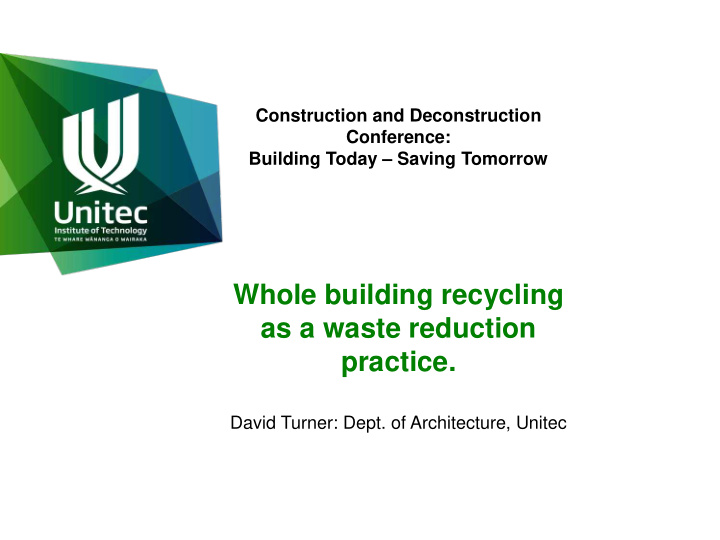



Construction and Deconstruction Conference: Building Today – Saving Tomorrow Whole building recycling as a waste reduction practice. David Turner: Dept. of Architecture, Unitec
Whole building recovery / recycling as a waste reduction practice Quantifiable construction/deconstruction benefits include: • reduction of waste to landfill • recovery of material resources • recycling embodied energy in existing building stock Other benefits: • Social benefits related to history of urban settlement, participation in process, etc. • Opportunity to revisit the developing commodification of houses – an increasingly common practice These apply equally to a variety of building typologies – schools, etc.; but this paper focuses on houses
New Zealand habits include a willingness to frequently ‘relocate’ buildings a practical option when our buildings are often lightly attached to the ground & when plans change we move approx. 2,600-3,200 houses annually (stats from HHA and SNZ) – 2/3rds of all HHA building removal consents estimated 90% are relocated & recycled into total housing stock St Mary’s Cathedral relocated to Holy Trinity, Parnell 1982 Google Earth image 12/6/14.
Craig Walker Collection, from Dawson, “Mighty Moves” p.230,
A skilled but unsophisticated process Craig Walker Collection, from Dawson, “Mighty Moves” p.238
Recycling by relocation minimizes landfill waste minimizes resource depletion (energy, timber, artifacts) speeds up process of supply avoids double handling (material recovery, material attrition) preserves physical housing stories (inscribed cultural integrity) re-invested energy estimated at approx. 600kWhrs/M 2 (compares to approx. 4,000kWhrs/M 2 for new housing) 2 case studies illustrate this practice (a) Kingsland-Waitoki villa (b) 379 West Coast Road Glen Eden
Kingsland-Waitoki villa, 2013: 3 years after move from Walters St., Mt Eden Photo: author
Google Earth image 22/5/15 379 West Coast Rd Glen Eden 5 relocated units Drawing courtesy Land Development + Civil Ltd
379 West Coast Rd Glen Eden: 2015: 4 relocated houses + 1 re-positioned Photos: author
379 West Coast Rd Glen Eden: 2015 2 units, in different stages of completion (above) new foundations to current building standards (right)
Variations in supply processes private owner-occupier purchasers (usually villas): villas generally move away from an urban site (CS.A) commercial developers: such as LDC. Company philosophy: “ Engineered solutions for people & environments ” (CS.B) others Investors buying in Auckland & moving units to Tokoroa, Rotorua, etc; includes HNZC moving houses to rationalize land holdings
Conclusions & suggestions • consider policies that could encourage & expand relocations – obstruct unnecessary demolitions • recognize social (qualitative) merits of relocatables • identify / plan for a realistic relocations programme • study relationship of supply costs to affordability statistics • require larger subdivisions to provide sections for relocatables – (example) • use gst mechanism to reward/penalize relocated houses v ‘mcmansions’ • most significant issue for C+D: resisting the creeping commodification of housing
Recent subdivision in west Auckland: approx 60 units, no applied design parameters sites like this could be consented with conditions
Recommend
More recommend